Development of Mineral-Bonded Plywood with Magnesium Oxychloride as a Binder Using the Hot-Pressing Process
Abstract
:1. Introduction
2. Materials and Methods
2.1. Materials
2.2. Production of MOC Binder
2.3. Production of Plywood
2.4. Binder Characterization
2.5. Plywood Characterization
- (A)
- Immersion for 24 h in tap water (at 20 ± 3 °C);
- (B)
- Immersion for 6 h in boiling water followed by cooling in tap water (at 20 ± 3 °C) for at least 1 h.
3. Results and Discussion
3.1. Binder Characterization
3.2. Mechanical Properties
3.2.1. Shear Strength Analysis
3.2.2. Bending Properties
| Wood Specie | Type of Binder | Standard Test Method 2 | Flexural Modulus (MPa) | Flexural Strength (MPa) | Shear Strength (MPa) | Reference | |
|---|---|---|---|---|---|---|---|
| 24 h Water Soaking | Water Boiling | ||||||
| Poplar | UF | EN 314 | 9050 | 74 | 0.27 | 0 | [13] |
| Beech | Tannin-furfural | EN 314 | 11,628 | 85 | 0 | - | [35] |
| Poplar | Soy protein | GB/T 17657 | - | - | 0.35 | - | [36] |
| Poplar | Chitosan | GB/T 17657 | - | - | 0.38 | 0.2 | [37] |
| Poplar | Geopolymer | EN 314 | 8734 | 76 | 0.54 | 0.52 | [38] |
| Poplar | MOC 1 | GB/T 17657 | - | - | 0.88 | - | [17] |
| Poplar | MOC | EN 314 | 9640 | 59 | 0.62 | 0.55 | Current study |
3.2.3. Delamination Test
3.3. Physical Properties
4. Conclusions
Author Contributions
Funding
Institutional Review Board Statement
Data Availability Statement
Acknowledgments
Conflicts of Interest
References
- Hemmilä, V.; Adamopoulos, S.; Karlsson, O.; Kumar, A. Development of sustainable bio-adhesives for engineered wood panels-A Review. RSC Adv. 2017, 7, 38604–38630. [Google Scholar] [CrossRef]
- Ferdosian, F.; Pan, Z.; Gao, G.; Zhao, B. Bio-based adhesives and evaluation for wood composites application. Polymers 2017, 9, 70. [Google Scholar] [CrossRef]
- Solt, P.; Konnerth, J.; Gindl-Altmutter, W.; Kantner, W.; Moser, J.; Mitter, R.; van Herwijnen, H.W.G. Technological performance of formaldehyde-free adhesive alternatives for particleboard industry. Int. J. Adhes. Adhes. 2019, 94, 99–131. [Google Scholar] [CrossRef]
- Collins, J.J.; Lineker, G.A. A review and meta-analysis of formaldehyde exposure and leukemia. Regul. Toxicol. Pharmacol. 2004, 40, 81–91. [Google Scholar] [CrossRef]
- Shalbafan, A.; Welling, J.; Hasch, J. Effect of aluminosilicate powders on the applicability of innovative geopolymer binders for wood-based composites. Eur. J. Wood Wood Prod. 2017, 75, 893–902. [Google Scholar] [CrossRef]
- Petrič, M. Influence of silicon-containing compounds on adhesives for and andhesion to wood and lignocellulosic materials: A critical review. Rev. Adhes. Adhes. 2018, 6, 26–81. [Google Scholar] [CrossRef]
- Moslemi, A.A. Wood Composites: Mineral-Bonded. In Encyclopedia of Materials: Science and Technology; Elsevier: Amsterdam, The Netherlands, 2001; pp. 9609–9612. [Google Scholar]
- Atoyebi, O.D.; Awolusi, T.F.; Davies, I.E.E. Artificial neural network evaluation of cement-bonded particle board produced from red iron wood (Lophira alata) sawdust and palm kernel shell residues. Case Stud. Constr. Mater. 2018, 9, e00185. [Google Scholar] [CrossRef]
- Mehrez, I.; Hachem, H.; Jemni, A. Thermal insulation potential of wood-cereal straws/plaster composite. Case Stud. Constr. Mater. 2022, 17, e01353. [Google Scholar] [CrossRef]
- Simatupang, M.H. Technologies for rapid production of mineral-bonded wood composite boards. Prod. J. 1991, 2, 10–18. [Google Scholar]
- Direske, M.; Wenderdel, C. Detlef Krug Cement as an inorganic binder for the production of formaldehyde free bonded plywood. PRO Ligno 2018, 14, 16–22. [Google Scholar]
- Berzins, A.; Morozovs, A.; Van Den Bulcke, J.; Van Acker, J. Softwood surface compatibility with inorganic geopolymer. Adv. Mater. Proc. 2017, 2, 793–798. [Google Scholar] [CrossRef]
- Bahrami, M.; Shalbafan, A.; Welling, J. Development of plywood using geopolymer as binder: Effect of silica fume on the plywood and binder characteristics. Eur. J. Wood Wood Prod. 2019, 77, 981–994. [Google Scholar] [CrossRef]
- Allahverdipoorazar, F.; Shalbafan, A.; Berthold, D. Geopolymer as a multifunctional mineral binder to produce laminated veneer lumber: Effect of various aluminosilicate powder types on panels and geopolymer binder features. Eur. J. Wood Wood Prod. 2021, 79, 349–362. [Google Scholar] [CrossRef]
- Shalbafan, A.; Thoemen, H. Geopolymer-bonded laminated veneer lumber as environmentally friendly and formaldehyde-free product: Effect of various additives on geopolymer binder features. Appl. Sci. 2020, 10, 593. [Google Scholar] [CrossRef]
- Ye, H.; Asante, B.; Schmidt, G.; Krause, A.; Zhang, Y.; Yu, Z. Interfacial bonding properties of the eco-friendly geopolymer-wood composites: Influences of embedded wood depth, wood surface roughness, and moisture conditions. J. Mater. Sci. 2021, 56, 7420–7433. [Google Scholar] [CrossRef]
- Jin, S.; Li, K.; Li, J.; Chen, H. A low-cost, formaldehyde-free and high flame retardancy wood adhesive from inorganic adhesives: Properties and performance. Polymers 2017, 9, 513. [Google Scholar] [CrossRef] [PubMed]
- Aiken, T.A.; Russell, M.; McPolin, D.; Bagnall, L. Magnesium oxychloride boards: Understanding a novel building material. Mater. Struct. 2020, 53, 118. [Google Scholar] [CrossRef]
- Nobre, J.; Ahmed, H.; Bravo, M.; Evangelista, L.; De Brito, J. Magnesia (MgO) production and characterization, and its influence on the performance of cementitious materials: A review. Materials 2020, 13, 4752. [Google Scholar] [CrossRef] [PubMed]
- Zhou, X.; Li, Z. Light-weight wood-magnesium oxychloride cement composite building products made by extrusion. Constr. Build. Mater. 2012, 27, 382–389. [Google Scholar] [CrossRef]
- Zhou, W.; Ye, Q.; Shi, S.Q.; Fang, Z.; Gao, Q.; Li, J. A strong magnesium oxychloride cement wood adhesive via organic-inorganic hybrid. Constr. Build. Mater. 2021, 297, 123776. [Google Scholar] [CrossRef]
- Liu, Z.; Balonis, M.; Huang, J.; Sha, A.; Sant, G. The influence of composition and temperature on hydrated phase assemblages in magnesium oxychloride cements. J. Am. Ceram. Soc. 2017, 100, 3246–3261. [Google Scholar] [CrossRef]
- Aiken, T.A.; Russell, M.; McPolin, D.; Gavin, B.; Nugent, L.; Bagnall, L. Effect of molar ratios and curing conditions on the moisture resistance of magnesium oxychloride cement. J. Mater. Civ. Eng. 2022, 34, 04021426. [Google Scholar] [CrossRef]
- Sglavo, V.M.; De Genua, F.; Conci, A.; Ceccato, R.; Cavallini, R. Influence of curing temperature on the evolution of magnesium oxychloride cement. J. Mater. Sci. 2011, 46, 6726–6733. [Google Scholar] [CrossRef]
- Zheng, W.; Xiao, X.; Wen, J.; Chang, C.; An, S.; Dong, J. Water-to-cement ratio of magnesium oxychloride cement foam concrete with caustic dolomite powder. Sustainability 2021, 13, 2429. [Google Scholar] [CrossRef]
- Shalbafan, A.; Thoemen, H. Influence of pressing schedule and adhesive content on the rheological behavior of wood fiber-furnish mats. Materials 2022, 15, 1413. [Google Scholar] [CrossRef] [PubMed]
- Ozyhar, T.; Depnering, T.; Ridgway, C.; Welker, M.; Schoelkopf, J.; Mayer, I.; Thoemen, H. Utilization of inorganic mineral filler material as partial replacement for wood fiber in medium density fiberboard (MDF) and its effect on material properties. Eur. J. Wood Wood Prod. 2020, 78, 75–84. [Google Scholar] [CrossRef]
- Pizzi, A.; Mittal, K.L. Handbook of Adhesive Technology, Revised and Expanded, 3rd ed.; Taylor & Francis: Boca Raton, FL, USA, 2018; ISBN 9781498736442. [Google Scholar]
- Gadhave, R.V.; Mahanwar, P.A.; Gadekar, P.T. Factor Affecting Gel Time/Process-Ability of Urea Formaldehyde Resin Based Wood Adhesives. Open J. Polym. Chem. 2017, 7, 33–42. [Google Scholar] [CrossRef]
- Tan, Y.; Liu, Y.; Grover, L. Effect of phosphoric acid on the properties of magnesium oxychloride cement as a biomaterial. Cem. Concr. Res. 2014, 56, 69–74. [Google Scholar] [CrossRef]
- Jiříčková, A.; Lojka, M.; Lauermannová, A.-M.; Antončík, F.; Sedmidubský, D.; Pavlíková, M.; Záleská, M.; Pavlík, Z.; Jankovský, O. Synthesis, structure, and thermal stability of magnesium oxychloride 5Mg (OH)2∙ MgCl2∙ 8H2O. Appl. Sci. 2020, 10, 1683. [Google Scholar] [CrossRef]
- Wang, W.; Guo, X.; Zhao, D.; Liu, L.; Zhang, R.; Yu, J. Water absorption and hygrothermal aging behavior of wood-polypropylene composites. Polymers 2020, 12, 782. [Google Scholar] [CrossRef]
- Deng, D. The mechanism for soluble phosphates to improve the water resistance of magnesium oxychloride cement. Cem. Concr. Res. 2003, 33, 1311–1317. [Google Scholar] [CrossRef]
- Na, B.; Wang, H.; Ding, T.; Lu, X. Influence of wet and dry cycle on properties of magnesia-bonded wood-wool panel. Wood Res. 2020, 65, 271–282. [Google Scholar] [CrossRef]
- Jorda, J.; Cesprini, E.; Barbu, M.-C.; Tondi, G.; Zanetti, M.; Král, P. Quebracho tannin bio-based adhesives for plywood. Polymers 2022, 14, 2257. [Google Scholar] [CrossRef] [PubMed]
- Luo, J.; Luo, J.; Yuan, C.; Zhang, W.; Li, J.; Gao, Q.; Chen, H. An eco-friendly wood adhesive from soy protein and lignin: Performance properties. RSC Adv. 2015, 5, 100849–100855. [Google Scholar] [CrossRef]
- Xi, X.; Pizzi, A.; Lei, H.; Zhang, B.; Chen, X.; Du, G. Environmentally friendly chitosan adhesives for plywood bonding. Int. J. Adhes. Adhes. 2022, 112, 103027. [Google Scholar] [CrossRef]
- Shalbafan, A.; Nadali, A.; Thoemen, H. A multifunctional mineral binder for plywood production: The effect of manufacturing parameters on bonding quality. Materials 2020, 13, 2360. [Google Scholar] [CrossRef]
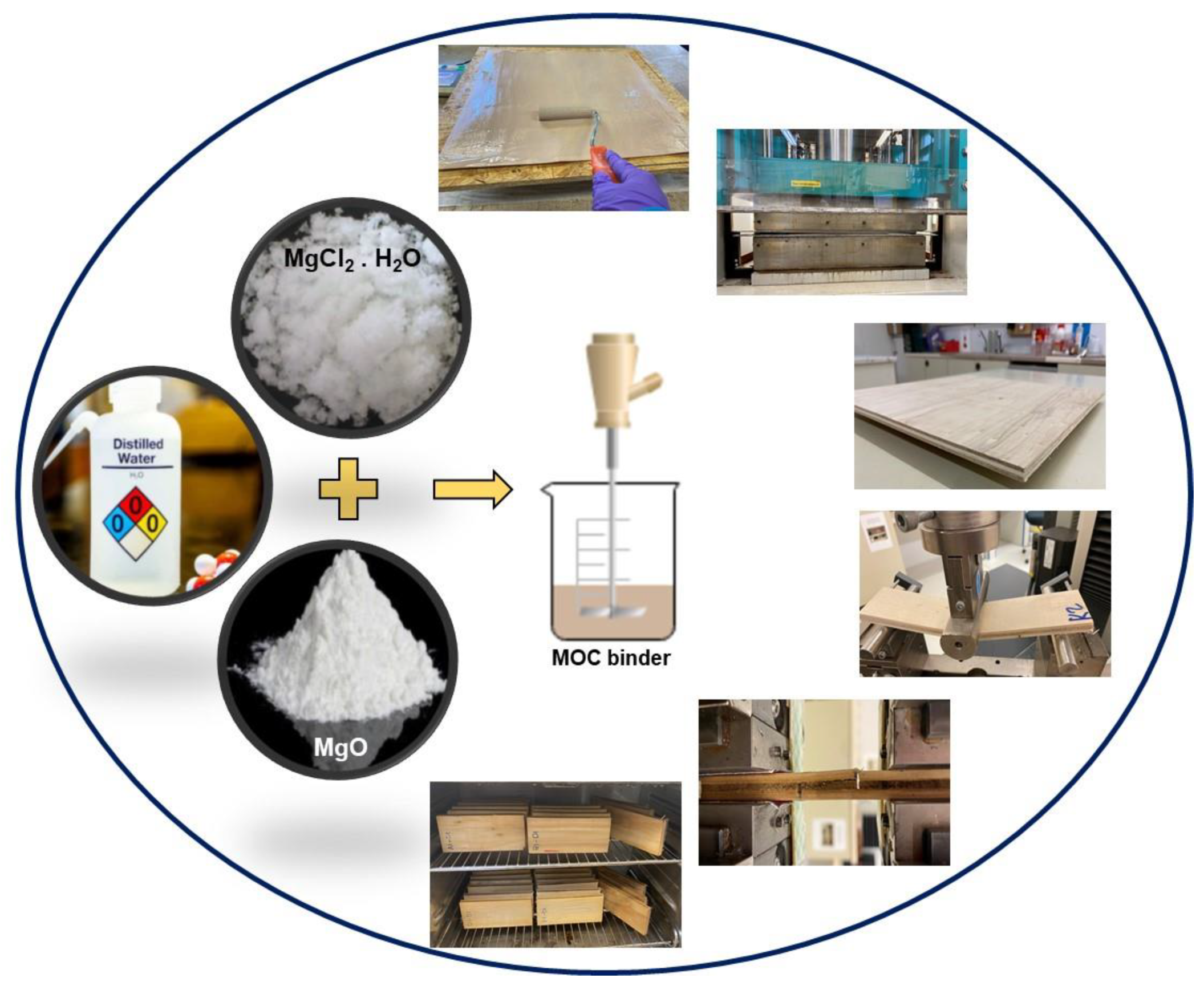

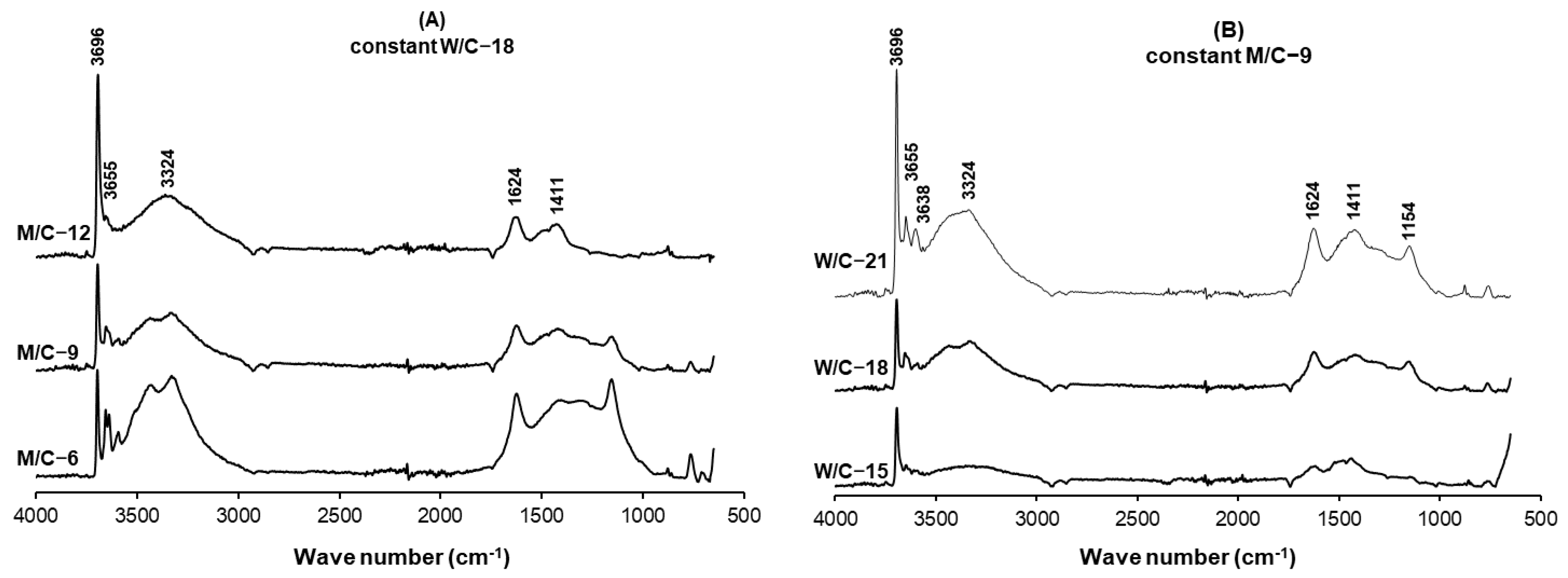

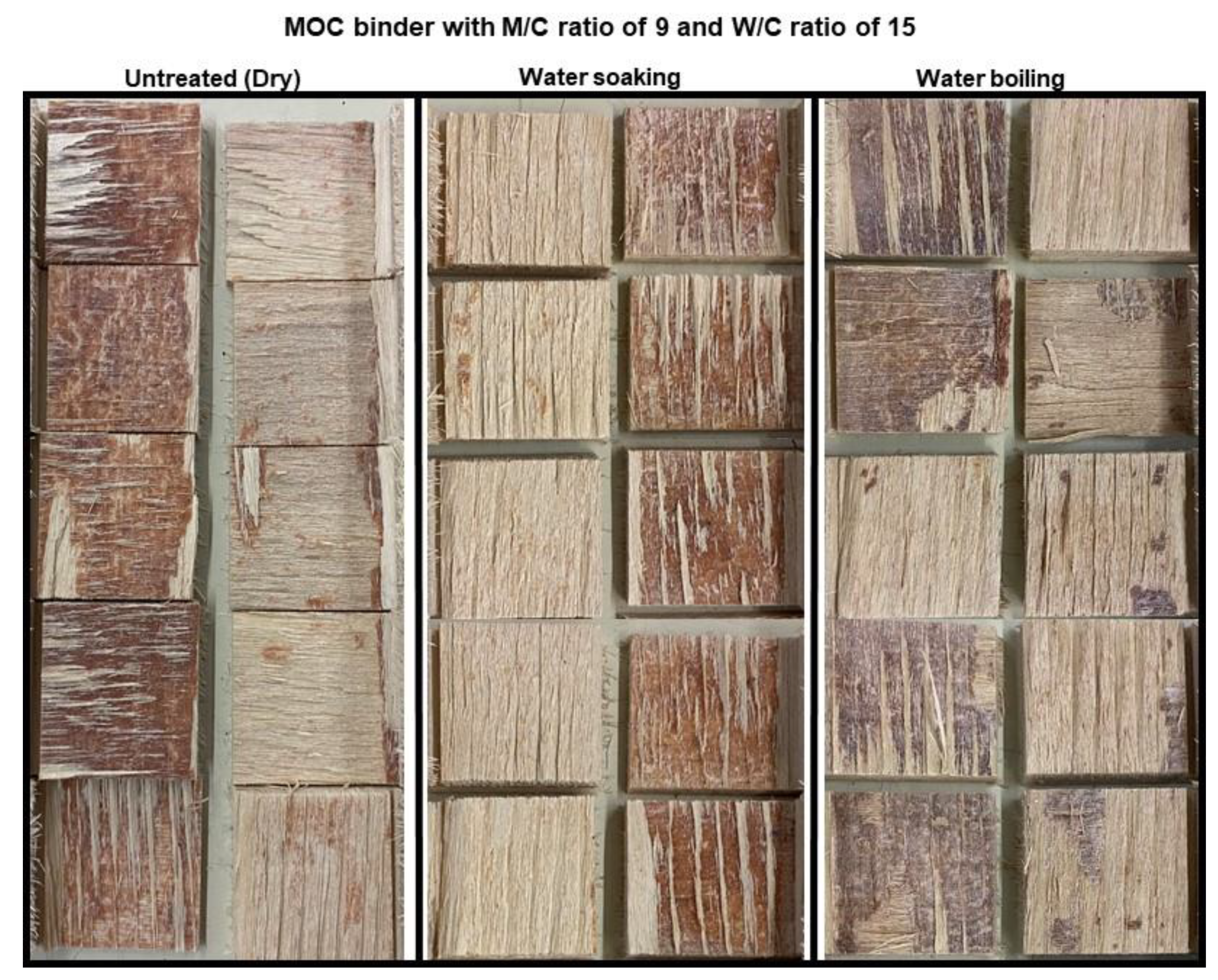


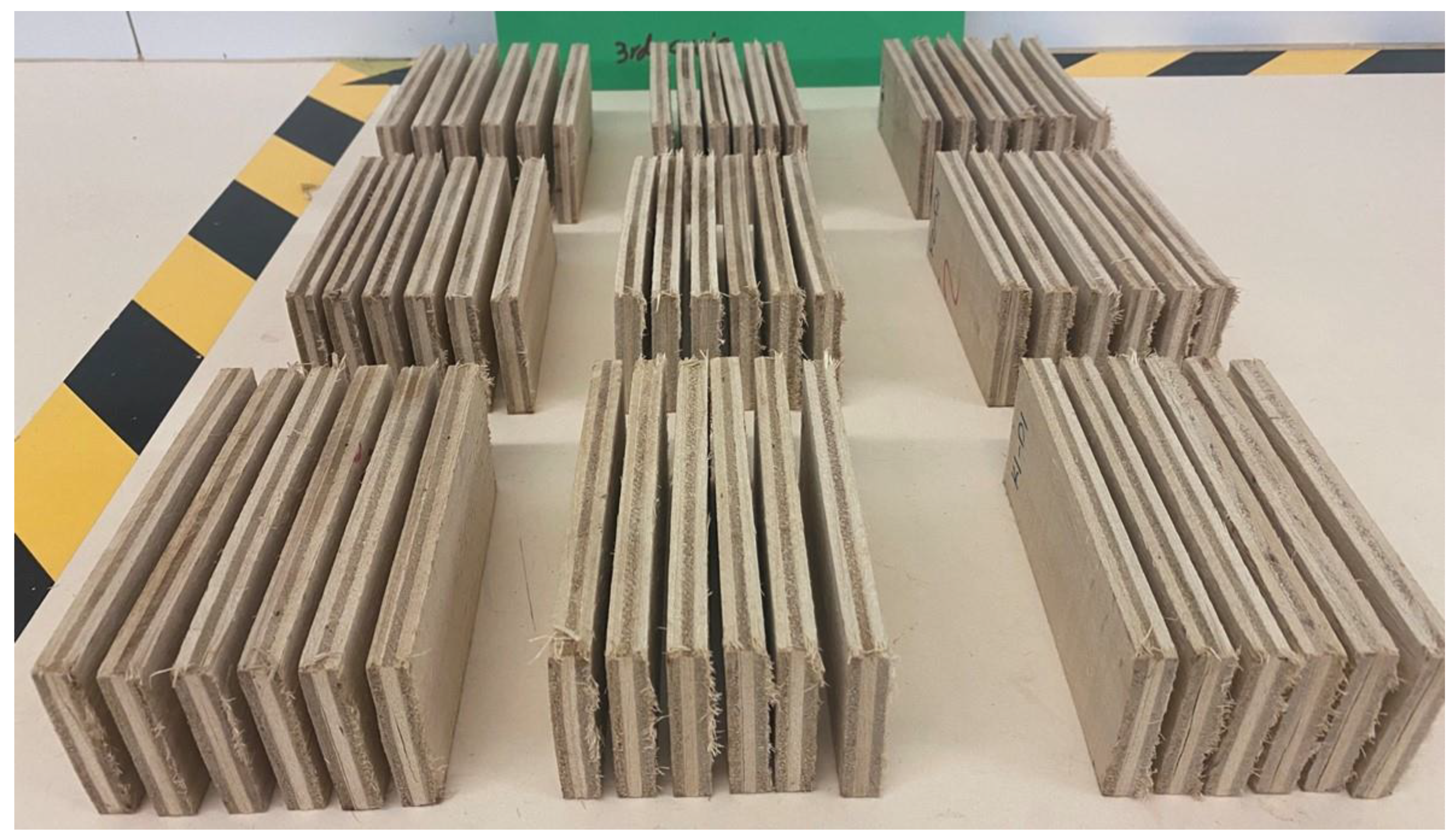
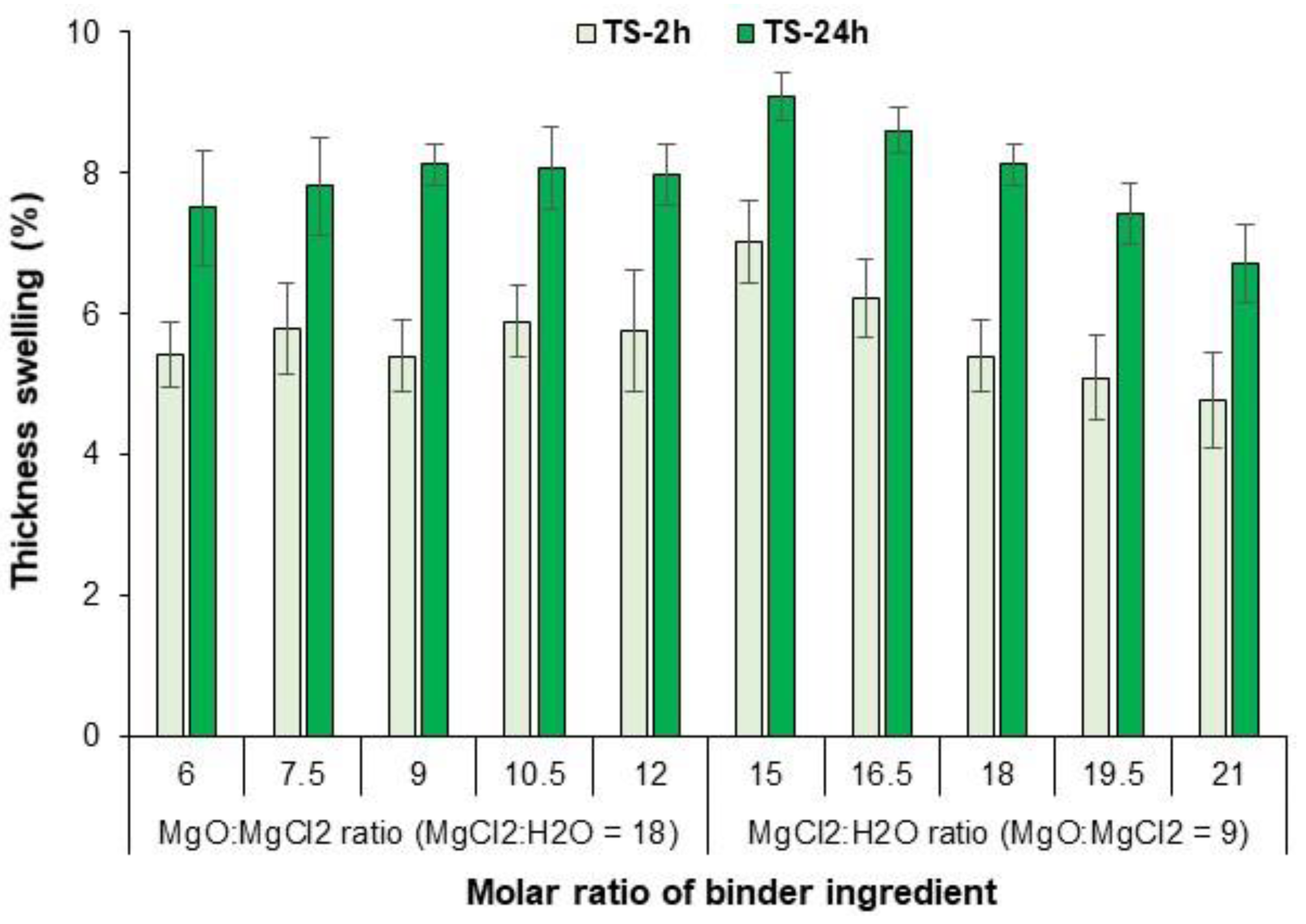

| Material | MgO | CaO | SiO2 | Al2O3 | Fe2O3 |
|---|---|---|---|---|---|
| Magnesium oxide | 92.60% | 1.80% | 1.33% | 0.10% | 0.48% |
| Material | MgCl2 | MgSO4 | KCl | NaCl | CaCl2 | Water |
|---|---|---|---|---|---|---|
| Magnesium chloride | 47.0% | 0.43% | 0.67% | 0.65% | 0.05% | Approx. 51% |
| Code * | Molar Ratio of MgO:MgCl2 | Molar Ratio of H2O:MgCl2 | Binder Solid Content (%) |
|---|---|---|---|
| M/C-6 | 6.0 | 18.0 | 50.8 |
| M/C-7.5 | 7.5 | 18.0 | 55.0 |
| M/C-9 | 9.0 | 18.0 | 58.5 |
| M/C-10.5 | 10.5 | 18.0 | 61.5 |
| M/C-12 | 12.0 | 18.0 | 64.1 |
| W/C-15 | 9.0 | 15.0 | 62.9 |
| W/C-16.5 | 9.0 | 16.5 | 60.6 |
| W/C-18 | 9.0 | 18.0 | 58.5 |
| W/C-19.5 | 9.0 | 19.5 | 56.6 |
| W/C-21 | 9.0 | 21.0 | 54.7 |
| Code | pH | Setting Time (s) | DSC Parameters | ||
|---|---|---|---|---|---|
| Onset Temperature (°C) | Peak Temperature (°C) | Delta H (J/g) | |||
| M/C-6 | 8.65 | 155.3 | 82.7 | 98.3 | 342.8 |
| M/C-9 | 8.57 | 139.3 | 81.7 | 97.4 | 370.9 |
| M/C-12 | 8.62 | 116.3 | 80.8 | 96.7 | 375.6 |
| W/C-15 | 8.29 | 124.7 | 84.8 | 99.3 | 269.9 |
| W/C-18 | 8.57 | 139.3 | 81.7 | 97.4 | 370.9 |
| W/C-21 | 8.96 | 142.0 | 82.3 | 97.9 | 461.6 |
| UF * | 8.05 | 213.3 | 77.5 | 92.8 | 126.0 |
Disclaimer/Publisher’s Note: The statements, opinions and data contained in all publications are solely those of the individual author(s) and contributor(s) and not of MDPI and/or the editor(s). MDPI and/or the editor(s) disclaim responsibility for any injury to people or property resulting from any ideas, methods, instructions or products referred to in the content. |
© 2023 by the authors. Licensee MDPI, Basel, Switzerland. This article is an open access article distributed under the terms and conditions of the Creative Commons Attribution (CC BY) license (https://creativecommons.org/licenses/by/4.0/).
Share and Cite
Shalbafan, A.; Thoemen, H. Development of Mineral-Bonded Plywood with Magnesium Oxychloride as a Binder Using the Hot-Pressing Process. Polymers 2023, 15, 805. https://doi.org/10.3390/polym15040805
Shalbafan A, Thoemen H. Development of Mineral-Bonded Plywood with Magnesium Oxychloride as a Binder Using the Hot-Pressing Process. Polymers. 2023; 15(4):805. https://doi.org/10.3390/polym15040805
Chicago/Turabian StyleShalbafan, Ali, and Heiko Thoemen. 2023. "Development of Mineral-Bonded Plywood with Magnesium Oxychloride as a Binder Using the Hot-Pressing Process" Polymers 15, no. 4: 805. https://doi.org/10.3390/polym15040805
APA StyleShalbafan, A., & Thoemen, H. (2023). Development of Mineral-Bonded Plywood with Magnesium Oxychloride as a Binder Using the Hot-Pressing Process. Polymers, 15(4), 805. https://doi.org/10.3390/polym15040805






